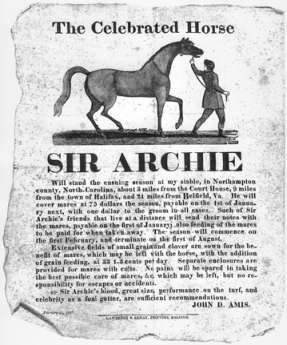Carney, Stephen Wright
1762–27 Dec. 1811
Stephen Wright Carney, legislator, general of the state militia, racehorse owner, and enslaver was born in Norfolk County, Va. He was the son of Richard Carney, a wealthy planter, vestryman, and enslaver of Portsmouth Parish. Carney's great-great-grandfather, William Carney, emigrated from England to Virginia in 1650 and died in Norfolk County in 1683. Richard Carney bought land in Halifax County, N.C., in 1777 but did not actually move the family there until about 1780. At this time the family consisted of Stephen; his brother, Richard, Jr.; sisters Nancy, who later married Roderick Cotten, and Elizabeth, who married Thomas Veale; and their mother, Mary. Another sister, Mary, had been married in 1770 to Slaughter Coffield of Nansemond County, Va., where she remained until after his death in 1785; at that time she moved to North Carolina as well. Richard Carney, Sr., prospered in Halifax County, becoming one of the largest land owners and enslavers in the county., He was also a justice, a post he resigned in 1789. His death on Dec. 18, 1792 was noted in an obituary in the 3 Jan. 1793 issue of the North Carolina Journal.
 Stephen W. Carney in about 1790 married Priscilla Coffield West, widow of Israel West of Halifax County and daughter of West Coffield of Edgecombe County. Like his father, he prospered as a planter. At one point he owned several thousand acres of land and enslaved thirty people. His home, shown on the Price-Strother map of 1808, was located near present Tillery in Halifax County and was frequently the scene of lavish entertainment and political discussion.
Stephen W. Carney in about 1790 married Priscilla Coffield West, widow of Israel West of Halifax County and daughter of West Coffield of Edgecombe County. Like his father, he prospered as a planter. At one point he owned several thousand acres of land and enslaved thirty people. His home, shown on the Price-Strother map of 1808, was located near present Tillery in Halifax County and was frequently the scene of lavish entertainment and political discussion.
His political career officially began in 1791, when he was appointed representative to the House of Commons from Halifax County to complete the term of Thomas Tabb, who had died in office. Carney was elected to the house in his own right in 1793 and 1795. In 1796 he was elected state senator, a post to which he was reelected annually until 1803. Politically, he was a protégé of William R. Davie, whose post as major general of the Third Division of the state militia he was chosen to fill upon Davie's election as governor of North Carolina in December 1798. Starting as a major in the state militia in 1793, he rose to command the militia in five years and remained active in the organization until his death.
Horse-racing was the leading sport of the day among Eastern North Carolina planters, and Carney was one of its foremost figures. His imported thoroughbreds were widely sought after for breeding and were victorious on the leading tracks of North Carolina and Virginia. His most famous import was Citizen, purchased in England in 1803. Citizen had been one of the leading horses of his day in England and was brought to this country exclusively for breeding. Carney's Blank, a son of Centinel, raced Sir Archie in Scotland Neck in 1809, in the most celebrated race of its time. Blank lost, but it was the only time before or after that he did so.
After leaving the legislature, Carney, like his father, became a justice of Halifax County. He was active in the Masonic Lodge in Halifax and in 1811 was grand junior deacon of North Carolina Masons.
Priscilla Carney died 8 Feb. 1810, and on 6 Jan. 1811, Carney married Anne Northcott of Norfolk county, Va. Carney died at his home in Halifax, leaving no issue by either marriage, though he had a large number of nieces and nephews. His widow was married on 25 Aug. 1812 to Captain (later General) John Hodges of Norfolk County, Va., where she died 7 Mar. 1814.
References:
Elizabeth Amis Cameron Blanchard and Manly Wade Wellman, The Life and Times of Sir Archie (1958).
Court records of Edgecombe and Halifax counties (North Carolina State Archives, Raleigh) and of Norfolk County, Va. (Great Bridge, Va.).
Walter Clark, ed., State Records of North Carolina, vol. 21 (1903).
Coffield-Bellamy Papers (Southern Historical Collection, University of North Carolina, Chapel Hill).
George Cabell Greer, Early Virginia Immigrants (1912).
North Carolina Journal, scattered issues, 1793–1811.
North Carolina Manual (1913).
Raleigh Register, 17 Jan. 1812.
Raleigh Star, 15 Feb. 1810.
Register of Officers, North Carolina Militia (1800).
Blackwell P. Robinson, William R. Davie (1957).
Virginia Magazine of History and Biography 17 (1909–10).
Additional Resources:
Coffield and Bellamy Family Papers, 1723-1920 (collection no. 03162). The Southern Historical Collection. Louis Round Wilson Special Collections Library. University of North Carolina at Chapel Hill. http://www.lib.unc.edu/mss/inv/c/Coffield_and_Bellamy_Family.html (accessed July 15, 2013).
Image Credits:
An 1827 broadside produced by John Amis, Sir Archie's owner, advertising the horse at stud. From the Cameron Family Papers, no. 133, Southern Historical Collection, Wilson Library, UNC-Chapel Hill.
1 January 1979 | Modlin, J. Wayne